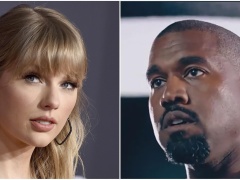
Clive Davis doesn’t do anything by half, and his 90th birthday is no exception. Not only will there be a star-studded party tonight at Cipriani in Lower Manhattan, there’s a four-part music-and-interview series on Paramount Plus culled from last year’s virtual pre-Grammy galas; a Clive Davis Gallery with personal items from across his career at New York University’s Brooklyn location; an interview on the “Rock & Roll High School With Pete Ganbarg” podcast airing April 14; a talk at the 92 St. Y on April 21; and two comprehensive, detailed articles here at PvNew.
With two autobiographies, a documentary film and literally thousands of interviews over the course of his 60-plus year career, Davis’ history — from his childhood in Brooklyn to his early years at Columbia Records, to founding Arista and J Records and his current role as chief creative artist at Sony Music — has been well-documented, as has the crucial role he played in the careers of artists ranging from Simon & Garfunkel to Santana, Whitney Houston to Puff Daddy, Aretha Franklin to Alicia Keys and so many more. So for the main “Clive at 90” article, we spoke with many of the people who worked for him over the years, creating a rich alternate history of that career, which illuminates what a great executive, boss and mentor he is. You can read that article here. But we were offered an interview with the man himself as well.
I’ve interviewed Davis around a dozen times over the years, and each previous time, the famous stickler for “preparation, preparation, preparation” asked in advance what the interview would cover,and arrived with answers written on a stack of index cards that he pulled from an inside pocket of one of his immaculately tailored suits (which invariably had a pocket square that flawlessly matched his tie) and delivered well thought-out and carefully articulated answers. But this time, to my surprise, he said, “Jem, I haven’t prepared anything, so I’m doing this spontaneously. I’m going to monologue for a little while, if you don’t mind.”
We don’t mind! What follows is an edited version of that discussion, which goes all the way back to 1965 and includes pearls of wisdom about music, working with talent and presenting it in the best possible light, managing and mentoring a team, keeping up with changing times — and crucially, remaining open to other opinions and perspectives.
When I was made head of Columbia Records in 1965, it was a total, unexpected appointment. I’d had no ambition for it, and it was through lucky breaks that I got it. I’m eternally indebted to [his predecessor] Goddard Lieberson for giving me the position and then, somehow, letting me do my thing — not that he knew I would have ears, or that I knew I would have ears.
So, picture Columbia Records at the time: preeminent in Broadway and classical music, and steeped in very formidable, very successful middle-of-the-road artists: Andy Williams, Tony Bennett, Barbra Streisand. And the esteemed A&R men who worked with these artists really knew just that world. Mitch Miller, who was head of A&R before I became head of the company, never believed in rock music. He thought it would not last.
Yes, they had Bob Dylan, and Simon & Garfunkel had a hit single coming out with “Sounds of Silence.” But prior to that, they’d had Aretha Franklin, but they couldn’t come up with records that would break her: promotion would blame it on A&R, A&R would blame it on promotion and so on.
So with my immersion in music and my eventual signing of revolutionary rock artists like Janis Joplin, the Electric Flag, Laura Nyro, Santana, Chicago and Blood Sweat & Tears, I also introduced what we needed for these new artists — a number of new executives. And with these separate specialties and the brand-new signings, we had to have a company meeting where all this would be discussed. It was not just an A&R meeting: I had to have the heads of sales, the heads of radio promotion, marketing people, press people, product managers and others in order to formulate what the possibilities were.
I always have emphasized the importance of A&R, yet it can very easily happen that your A&R staff lives in an ivory tower and doesn’t hear the advice that comes from the practical experience of promotion. A healthy balance of the two was essential: let A&R pick the single, but take it through the test of promotion’s feedback. And so these meetings, beginning all those years ago at Columbia, would be a very healthy exchange, where every branch of the company would be heard and decisions were reached.
One memory that stands out is when Simon & Garfunkel played their [1970] “Bridge Over Troubled Water” album for me. Paul and Artie thought that I would have picked “Cecilia,” the more obvious single, but I chose “Bridge.” Now, in those days, major radio stations never would play a record over three or three-and-a-half minutes long, and this was a five-minute ballad. It was anything but formulaic. But from the creative point of view, sometimes you can’t go with formula.
And only in a meeting like that — where the promotion staff could point out the difficulties, that they couldn’t get this chain or this major station or crossover station — could you pass the word to promotion: You have to do everything you can to show that we know this one is different. And when the stations played it, the phones lit up at such a volume that it wasn’t just a hit record — it was a potential classic.
We got creative with other artists on the Columbia roster, also. We still had those unbelievable middle-of-the-road artists. How do you show that they could play Madison Square Garden? No promoter would pick it up, so I produced a concert at Madison Square Garden with Johnny Mathis, Percy Faith, Vicki Carr and a 40-piece orchestra. And it proved that, yes, 18,000 people would go to an arena to see these artists. We did the same thing with classical music — we took over Radio City Music Hall with the New York Philharmonic, the Philadelphia Orchestra and the Cleveland Orchestra with Leonard Bernstein, Eugene Ormandy, and George Szell. And when Bill Graham closed the Fillmore East and Fillmore West [in 1971], that led to my taking the Anderson Theatre [in New York] and putting on seven nights of concerts, mixing and matching Miles Davis with Bruce Springsteen and New Riders of the Purple Sage.
At Columbia, I had pretty much signed only self-contained artists who wrote their own material. But when I started Arista Records [in 1974], I knew I couldn’t do that because music had changed. On the one hand, there was new wave and punk rock, these brilliantly talented artists, and I wanted them to be part of Arista — Patti Smith, Lou Reed, Graham Parker, Stiff Records — and we even signed [veteran rock acts] like the Kinks and the Grateful Dead. But I wanted us to be a real competitor, and those artists were not destined to have multimillion-selling, platinum records.
So I hired a whole new A&R team who would help me see if I could hone my ears for artists who didn’t write. We started with Barry Manilow and Melissa Manchester, who needed hit songs to complement their writing. And then we signed Dionne Warwick, who needed songs in the tradition of the ones Burt Bacharach and Hal David wrote for her [in the ‘60s]. And eventually we did the same for Aretha and Whitney and Taylor Dayne. We invested in A&R for hundreds of songs, and then picking those few that we felt were the best — and the best place to test them was in the meeting, because the demos required imagination as to what they could translate into.
In those meetings, another method started to become clear. L.A. Reid and [Kenneth “Babyface” Edmonds] had had 19 number-one R&B records, but no number-one pop record. I realized that I and our A&R department were doing fine — but to really further progress as to how music was changing and where it was moving, I had to turn to the expertise of others.
And that’s when we financed the LaFace label, which brought us Usher, Toni Braxton, TLC, Pink — the artistry that L.A. and Babyface delivered added to what we were doing at the Arista label. And then when hip-hop began to rise — even though we’d had an original hip-hop [precursor] on Arista with Gil Scott-Heron years before — it was clearly showing that it was going to be a major, major part of contemporary music. [Sean “Diddy”/”Puff Daddy” Combs] convinced me that top 40 was going to embrace hip-hop. It seemed so unlikely then, but when he played me Craig Mack’s [1994 hit] “Flava in Ya Ear” and Notorious B.I.G. material when he was totally unknown, this 21-22 year-old guy was seeing clearly how music was changing.
So I brought him to the meeting to articulate what he had articulated to me, and we signed and financed Bad Boy Records and all marched together to break “Flava in Ya Ear,” Biggie, 112, Total, Faith Evans. And then we launched Arista Nashville with Tim DuBois and Mike Dungan, and it exploded right from the beginning with Alan Jackson, Brooks & Dunne, Pam Tillis, Diamond Rio, Brad Paisley. That added to LaFace and Bad Boy and what we were doing at Arista with Whitney, Dionne, Aretha and so many others. It was clearly a golden era.
All of what we’ve discussed today was purely empirical, reached by common sense, a hard-work ethic and a healthy respect for failure. What does it take to succeed? What are the obstacles? You’ve got to pour it on, knowing what could stand in your way — and who could bring something to your attention that could educate and develop you.
To this very day, I listen to the newest records as they reach, let’s say, the top 20 of each genre. I’ve always made sure that I didn’t listen only to what we were doing, and that I was aware and studying and totally cognizant. I found that many of my peers get stuck in what they’re doing, and weren’t prepared for how music was changing. And you’ve gotta know it. It was so tough, over the years, to tell an artist who’d had hit after hit after hit that the next record has to be different, because music has changed.
You’ve got to be astute. I did it and I still do it, because I love music.







